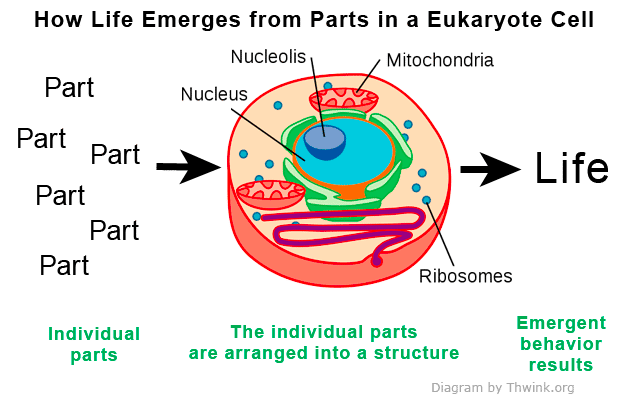Emergent Behavior
Emergent behavior is behavior of a system that does not depend on its individual parts, but on their relationships to one another. Thus emergent behavior cannot be predicted by examination of a system's individual parts. It can only be predicted, managed, or controlled by understanding the parts and their relationships. Emergent behavior is also known as emergence, emergent property, or “the whole is greater than the sum of the parts.” How emergent behavior works is illustrated by this diagram: 1

All systems are composed of individual parts. Something arranges the parts into a structure. The structure then determines the behavior of the system. System analysis is thus a matter of identifying the relevant structure of the system and its most important parts.
The key insight of the concept of emergent behavior is it's the arrangement of the parts, and not the parts themselves, that makes the big difference. The chemicals in the human body can be purchased for a few dollars. Buying them and mixing them up in a bucket, or even spending a hundred years to arrange them, would not create a person. That's why it's structure that makes all the diffference.
Examples of parts are atoms, the parts in a machine, people, and nations. Each of these is a system because it's made up of smaller parts. Each of these parts is in turn a part in a larger system.
Examples of structure are the social contract people enter into to form a government, the molecular structure of a chemical compound like carbon dioxide, and the way your cells are organized into organs, which are then organized into your body.
Examples of emergent behavior are life, the way the sun can serve as an energy source for billions of years, the dysfunctionality of a gang, and our favorite, the environmental sustainability problem.
Why this is important
The concept of emergent behavior is hugely important to solving the sustainability problem because it's emergent behavior that's the problem to solve. But when you examine how scholars, activists, politicians, and environmental organizations are analyzing the sustainability problem as a whole, you will discover they are not studying the relevant structure of the system as a whole. They are mostly studying individual parts or subsystems that are not that crucial to resolving the root causes. This is a grave error, pun intended.
The heart of the concept of systems thinking is that the behavior of a system is an emergent property of its structure, not its parts. Problem symptoms are emergent behaviors. Each symptom can be traced to particular aspects of the structure. It follows that if you don't know the structure of a complex social system problem, then you will be unable to solve the problem except by trial and error. For difficult problems this is impossible.
This leads to one of our key principles:
Key Principle
If you don't understand the structure of a difficult problem,
then you can't solve the problem.
This applies to all difficult complex system problems. The implications (as well as the opportunity) for the environmental movement are profound.
(1) The image at the top of this page was prepared by Thwink.org from this image of a cell in the Wikipedia entry for a biological cell.


























